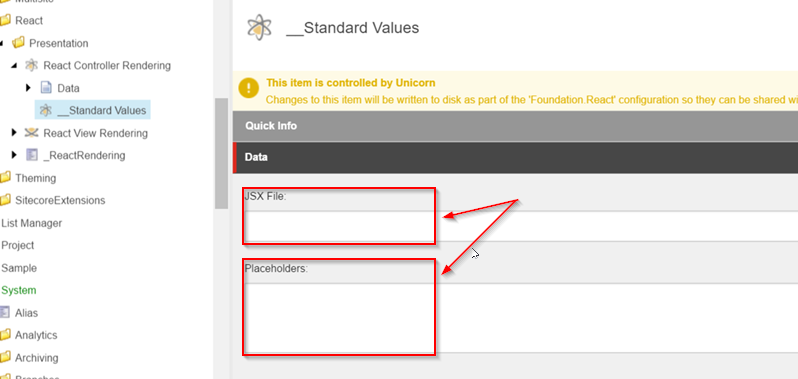
At Lightmaker we have had a number of discussions recently about how to streamline the front end build into a Sitecore environment. Our front end devs are all Mac based, so currently can’t run a local instance of Sitecore. TBH - it would be overkill for them to do that anyway. But how can they accurately test their code before it gets into a Sitecore rendering? Also how can we remove the process where front end make a fix and that fix has to then be applied to a razor view etc… The front end team should just be able to update markup and not have to worry about then integrating that back into a Sitecore rendering - warning - this may be a long post!
ReactJS - Is it an option?
Various ideas were discussed, Angular, a Jade view engine etc… Ultimately we looked to React as a tool to build the front end code with.
Why?
- Component-Based: Just like Sitecore React is component based, we can easily take a React component and match that to a rendering we would have built in Sitecore
- Front End Development doesn’t need to worry about Sitecore, ASP.NET MVC or Razor script. As long as they know React, they can build Sitecore components
- React is very efficient with DOM updates. React calculates the changes that need to be made in the DOM before making them and updates the DOM tree, avoiding costly DOM operations
- We can render the components on the server, making it great for SEO
At the same time we have been looking into this, some other blog posts have popped up with React+Sitecore ideas. These were an inspiration for our final solution: Sitecore and React: How Hard Can it Be showed a nice way that a react component could be built with WebForms, that takes the renderings datasource and adds it to the React model. But I didn’t want to use WebForms. On to Sitecore.Pathfinder, Here Jakob had taken what Alex did with WebForms and build a JsxRenderer - now we are not tied down to WebForms, which is great. But both of these solutions only cope with very simple renderings that only read data from a single Item without any manipulation before rendering it.
What are we trying to Achieve?
So what are our goals for this?
- Experience Editor must still work
- We must be able to build the data model as needed from the code
- FED should be able to develop components independently of Sitecore
- It should be easy to create a new React component in Sitecore. No jumping through hoops if we can help it!
This post will outline the method that Justin Laster @ Lightmaker and I came up with to use React with Sitecore. Note that our solution has been inspired by others and these will be credited throughout the post.
Controller Rendering - Not a great option
One option that we looked at was to use a Controller Rendering and then in the razor view use ReactJS.net to generate the React component. This worked, but had some major drawbacks.
First every React rendering would need 2 files creating. The jsx file and a cshtml file. It would look something like this:
- Helloworld.jsx
1
2
3
4
5var HelloWorld = React.createClass({
render: function() {
return <div>Hello world!</div>;
}
}); - Helloworld.cshtmlOn top of that, we need to register the jsx file with ReactJS and add it to a bundle. So multiple places that we have to set this up make it a bit of a maintenance headache!
1
2
3@model MyComponent.HelloWorldModel
@Html.React("HelloWorld", Model)
JsxViewEngine - Lets get serious
Lets crack this baby open! Here is the github repo for the React/Sitecore module can be found here - I have integrated this into the Habitat project so we have a site to work with.
First lets start by creating a new React Controller Rendering - we are creating this because we need to add a couple of fields that are not on a standard controller rendering:

The new fields are:
Jsx File: Pretty self explanatory, but this specifies the location of the Jsx file that contains our React component. While we can work this out from the controller action. This gives more flexibility if we want to include multiple components in a single Jsx file.Placeholders: This lists any placeholders that are present in our component. We need this here as currently we are not parsing the Jsx code directly to get the placeholders. This is on the roadmap to make easier.
Of course, we can’t forget to set a snappy icon - @jammykam would not be happy!
At this point we are still using a Controller Action to render our component. So we need to make that action return a JsxResult rather than a ViewResult.
1 | public class JsxResult : ViewResult |
Wait - where is the code!! For the JsxResult class we are just inheriting from the standard Mvc ViewResult. We don’t need to change any of the implementation here, but we have the class ready for future updates.
Next we need a view engine. The view engine tells us where to look for the jsx files:
1 | public class JsxViewEngine : BuildManagerViewEngine |
Again fairly standard stuff here. Its worth noting the paths for the .jsx files. They are setup to be in the same place as you would put your .cshtml files. This means we can still keep all our component parts together in the same project. We could customize this to be whatever folder structure fits the project, but this seemed like a good fit.
We need to make sure that the view engine is registered with asp.net. We can do this by adding an App_Start class and calling ViewEngines.Engines.Add(new JsxViewEngine());
Also notice that the CreateView and CreatePartialView methods are returning a JsxView object. Lets see what is in there:1
2
3
4
5
6
7
8
9
10
11
12
13
14
15
16
17
18
19
20
21
22
23
24
25
26
27
28
29
30
31
32
33
34
35
36
37
38
39
40
41
42
43
44
45
46
47
48
49
50
51
52
53
54
55
56
57
58
59
60
61
62
63
64
65
66
67
68
69
70
71
72
73
74
75
76
77
78
79
80
81
82
83public class JsxView : BuildManagerCompiledView
{
/*
* Properties and constructors removed for brevity
*/
internal Sitecore.Mvc.Presentation.Rendering Rendering => RenderingContext.Current.Rendering;
/// <summary>Renders the specified view context by using the specified writer and Jsx component.</summary>
/// <param name="viewContext">The view context.</param>
/// <param name="writer">The writer that is used to render the view to the response.</param>
/// <param name="instance">Not used in this view engine</param>
protected override void RenderView(ViewContext viewContext, TextWriter writer, object instance)
{
if (writer == null)
{
throw new ArgumentNullException(nameof(writer));
}
var componentName = Path.GetFileNameWithoutExtension(this.ViewPath)?.Replace("-", string.Empty);
var props = this.GetProps(viewContext.ViewData.Model);
IReactComponent reactComponent = this.Environment.CreateComponent(componentName, props);
writer.WriteLine(reactComponent.RenderHtml());
}
private IReactEnvironment Environment
{
get
{
try
{
return ReactEnvironment.Current;
}
catch (TinyIoCResolutionException ex)
{
throw new ReactNotInitialisedException("ReactJS.NET has not been initialised correctly.", ex);
}
}
}
protected virtual dynamic GetProps(object viewModel)
{
dynamic props = new ExpandoObject();
var propsDictionary = (IDictionary<string, object>)props;
dynamic placeholders = new ExpandoObject();
var placeholdersDictionary = (IDictionary<string, object>)placeholders;
propsDictionary["placeholders"] = placeholders;
propsDictionary["data"] = viewModel;
var placeholdersField = this.Rendering.RenderingItem.InnerItem["Place Holders"];
if (string.IsNullOrEmpty(placeholdersField))
{
return props;
}
var controlId = this.Rendering.Parameters["id"] ?? string.Empty;
dynamic placeholderId = null;
var placeholderKeys = placeholdersField.Split(Constants.Comma, StringSplitOptions.RemoveEmptyEntries).Select(p => p.Trim()).ToList();
foreach (var placeholderKey in placeholderKeys)
{
if (placeholderKey.StartsWith("$Id."))
{
if (placeholderId == null)
{
placeholderId = new ExpandoObject();
placeholdersDictionary["$Id"] = placeholderId;
}
((IDictionary<string, object>)placeholderId)[placeholderKey.Mid(3)] = PageContext.Current.HtmlHelper.Sitecore().Placeholder(controlId + placeholderKey.Mid(3)).ToString();
}
else
{
placeholdersDictionary[placeholderKey] = PageContext.Current.HtmlHelper.Sitecore().Placeholder(placeholderKey).ToString();
}
}
return props;
}
}
Ok - now we are getting to the bit that does the work. Ultimately its a pretty simple bit of code. First we get the component name from the ViewPath: var componentName = Path.GetFileNameWithoutExtension(this.ViewPath)?.Replace("-", string.Empty);. Then we can build the data model to be serialized and sent to the React component: var props = this.GetProps(viewContext.ViewData.Model);.
GetProps builds us a dynamic object with 2 root properties, data and placeholders. The data property will hold all the properties on the view model. Note that our view model must be serializable. The placeholders property holds the rendered contents of that placeholder. The contents of each placeholder is then added via the React code.
Finally we create the React component using ReactJS: IReactComponent reactComponent = this.Environment.CreateComponent(componentName, props); and then write that out to the TextWriter: writer.WriteLine(reactComponent.RenderHtml());.
You may be wondering tho - how does that work? Don’t you need to render the JavaScript somewhere, or register the jsx file with ReactJS? Well yes, we do. This is where we have taken a slightly different approach to previous posts. And it will all be dealt with in Part II here






